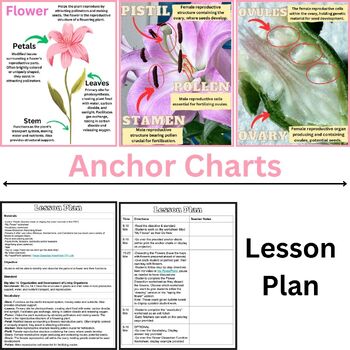Flower Dissection - Parts of a Flower Worksheets & Diagrams | Editable Lesson
- PPTX
Description
*The lesson plan portion of this product is editable.
This product includes a full editable lesson plan, a 'do now' worksheet, anchor charts, video directions, flower dissection worksheets, a vocabulary exit ticket, a coloring page, and answer keys. You can also purchase my PowerPoint presentation that complements this lesson perfectly. Tailored for your science block, this lesson spans approximately 35-65 minutes, allowing flexibility based on the time you have available. You can allocate more time for in-depth discussion of each function or expedite the process if you're running short on time.
Objective: Students will be able to identify and describe the parts of a flower and their functions.
Standard: Big Idea 14: Organization and Development of Living Organisms
Benchmark: SC.3.L.14.1 Describe structures in plants and their roles in food production, support, water, and nutrient transport, and reproduction.
Vocabulary:
-Stem: Functions as the plant’s transport system, moving water and nutrients. Also provides structural support.
-Leaves: Primary site for photosynthesis, creating plant food with water, carbon dioxide, and sunlight. Facilitates gas exchange, taking in carbon dioxide and releasing oxygen.
-Flower: Helps the plant reproduce by attracting pollinators and making seeds. The flower is the reproductive structure of a flowering plant.
-Petal: Modified leaves surrounding a flower’s reproductive parts. Often brightly colored or uniquely shaped, they assist in attracting pollinators.
-Stamen: Male reproductive structure bearing pollen crucial for fertilization.
-Pistil: Female reproductive structure containing the ovary, where seeds develop.
-Ovary: Female reproductive organ producing and containing ovules, potential seeds.
-Ovule: The female reproductive cell within the ovary, holding genetic material for seed development.
-Pollen: Male reproductive cell essential for fertilizing ovules.
You might also like the following products:
*Data Trackers for Students
*Data Trackers for Teachers
*Sub plan: letter to sub, schedule template, graphic organizer, behavior tracker
*Life Cycle of an Avocado
*Life Cycle of a Mango
*Garden Club Flyer & More
Classroom “Must Haves”
I have created lists on my Amazon Storefront of recess items I love having on hand as well as other classroom must haves. Look through my lists to see what classroom supplies you might need. https://www.amazon.com/shop/ela_leptiric
Tag me so I can see how you use this product in the classroom. I would love to share it with other educators so we can all learn from each other.
Instagram: @notaclassofficial
YouTube: @notaclass
Facebook: @notaclassofficial





